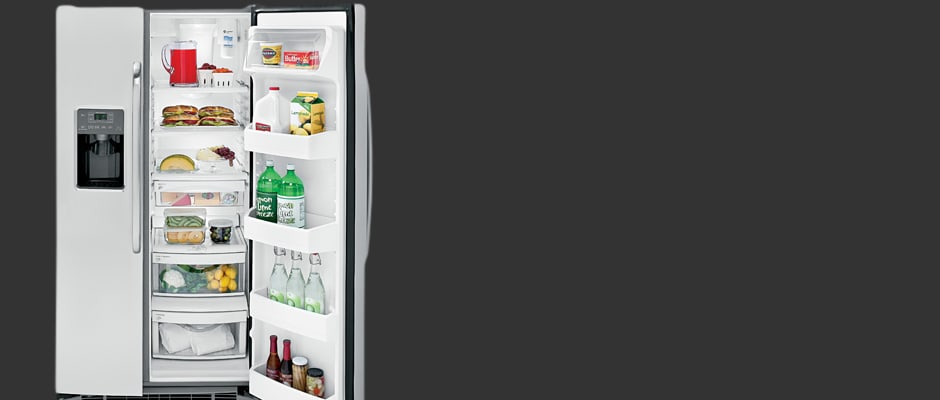Pros
Cons
Introduction
Front
{{section_header}}{{section.name}}{{/section_header}}
The front of the {{product.name}} has a stainless steel finish with matching handles set in the center. A through-the-door water and ice dispenser are located on the left door, which opens into the freezer. The right door accesses the fridge.
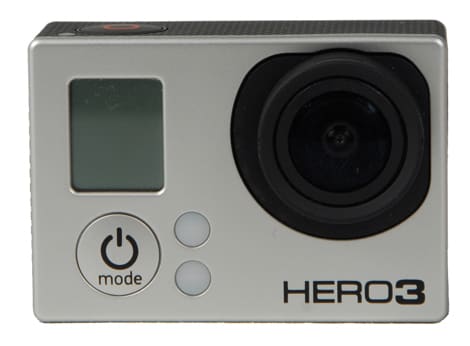
The stainless steel finish is a magnet for fingerprints. Nearly every smudge will be visible, but it cleans up nicely if you use special stainless steel cleaner.

The control panel is set above the water dispenser on the freezer door. Fridge and freezer temperatures can be adjusted separately, and are measured in degrees Fahrenheit. There are two warmer and colder buttons to raise and lower the temperatures, with the manufacturer's recommended setting just underneath that.

The handles are almost straight, curving at the top and bottom to meet flush with the two doors. They are also coated in stainless steel.

The water and ice dispenser is recessed into the freezer door, and is operated by pushing on a hard-to-miss paddle. The paddle itself is contoured to fit a glass-like shape, and only extends down for a portion of the whole cavity. A single spout emits water, crushed ice, and cubed ice. When the dispenser is being used, a small light comes on which will automatically turn off a few moments after it's no longer in use. The light can also be turned on permanently using a button on the control pad.

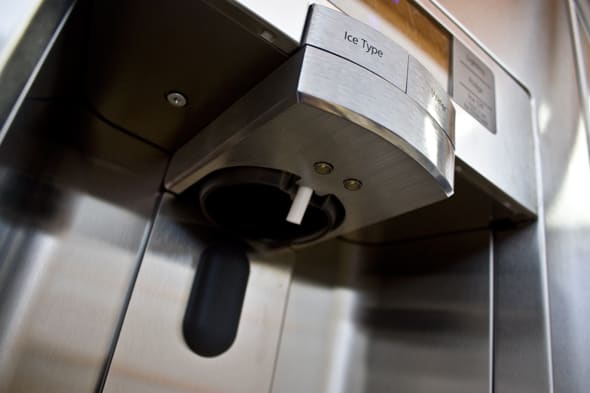
Interior
{{section_header}}{{section.name}}{{/section_header}}
A freezer on the left and a fridge on the right. A standard side-by-side design, there is also storage space available on both doors.
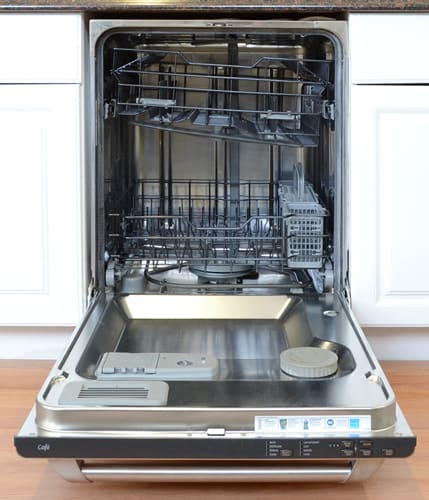
The interior of the CDWT980VSS.
The fridge interior has four shelves, three of which are adjustable, as well as three drawers. Most fridges will have a clear deli drawer just below eye level with two crisper drawers on the bottom, but the {{product.name}} goes a bit further in that respect. All three drawers are labeled as, from top to bottom, the "Snack Pan", "Fruits & Vegetables", and "Sealed Pan."
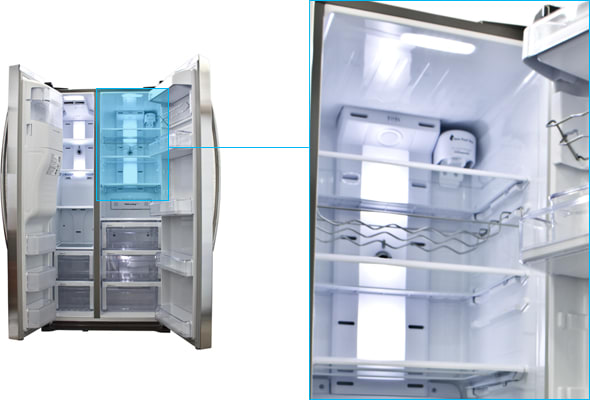
The water filter is located in the upper right corner at the top of the fridge. It's set at the back, so lots of food on the top shelf could prevent easy access.
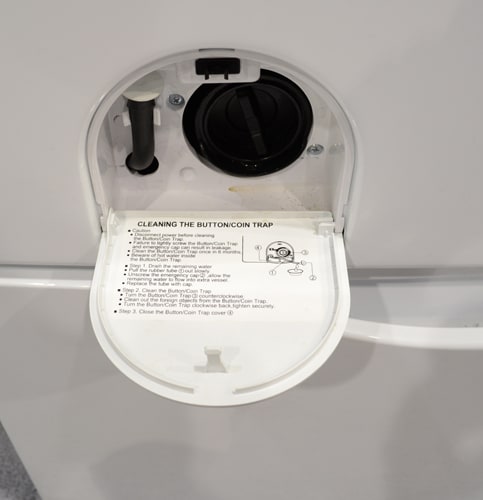
The door has a dairy tray at the top, and two larger adjustable shelves below that. Two smaller shelves, one of which is made of clear plastic as opposed to all the other opaque door shelves, are located at the bottom. These two can be removed, but not relocated.
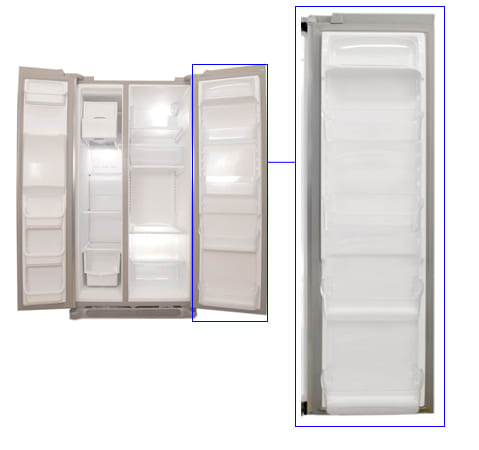
The freezer has a rather large ice maker located at the very top of the compartment. There are three wire shelves in the freezer, and the top one, located under the ice maker, is much shallower than the other two. At the bottom is a wire pull-out basket.
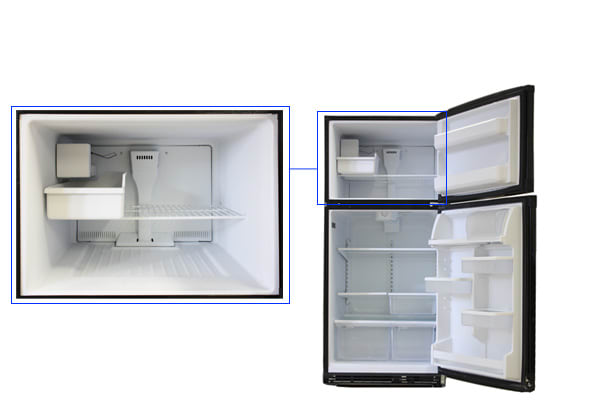
The freezer door of the {{product.name}} has a very small tray at the top, above the internal portion of the ice dispenser. Below that, near the bottom, are three shelves, with the lowest one just a bit smaller than the other two.
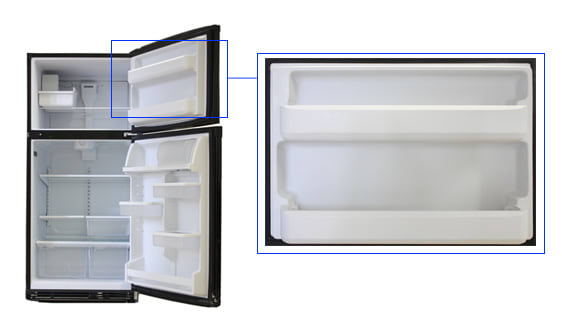
The ice maker is located at the very top of the freezer, and its large size can make it a bit unwieldy to remove. GE took this into account, however, and has placed a doggie-door style flap to allow access to bulk ice without having to pull out the whole machine.
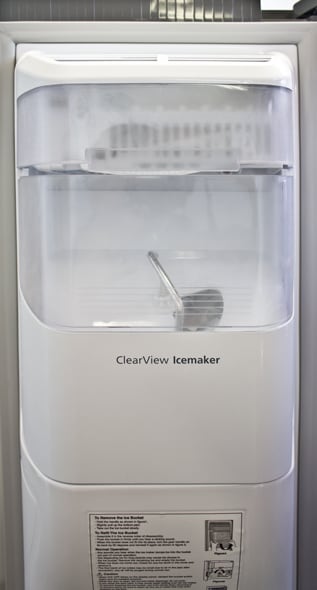
Back
{{section_header}}{{section.name}}{{/section_header}}
The back has a tube for the water filter and to the ice maker.
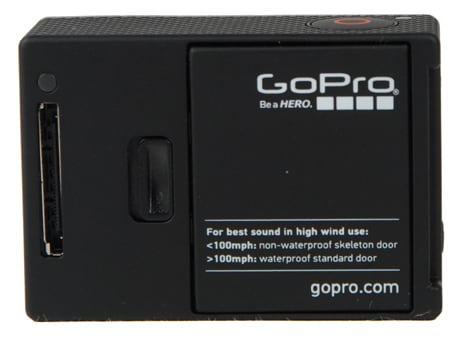
Sides
{{section_header}}{{section.name}}{{/section_header}}
The sides are finished with a gray matte texture which matches the stainless steel on the front.
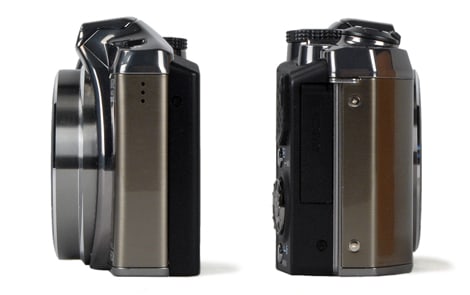
Olympus SZ-31MR iHS side views
Running Cost
{{section_header}}{{section.name}}{{/section_header}}
It's expected that a larger fridge will use a larger amount of energy. The amount of energy used, however, is not always exactly proportional to the overall size of the unit. The cost to power the {{product.name}} for a year, using a standard rate of $0.09 per kW-h, came out to $68.40. This amount is more or less in line with expectations set for larger fridges of this type, but that doesn't take away from the fact that it's a pretty hefty sum.
Power Use Per Cu Ft
{{section_header}}{{section.name}}{{/section_header}}
Despite being Energy Star certified, this fridge proved to be less efficient than many similar models in terms of energy use. By comparing the overall energy consumption with respect to storage space, the {{product.name}} used 0.14 kW-h per cubic foot. Though this isn't a wildly inefficient fridge, we've seen models that can certainly do better.
Fridge Temperature
{{section_header}}{{section.name}}{{/section_header}}
The {{product.name}}'s temperature was fairly consistent over time, but there was a change in degree from top to bottom. Though we adjusted the fridge to the manufacturer's calibration and the fridge's own temperature display said 37 degrees, it still ran a bit warmer at the top than is ideal. The bottom, conversely, ran closer to the ideal temperature. This problem is usually reversed side-by-sides, with the vent at the top producing colder air that warms as it falls. An easy remedy would be to keep your most perishable items in the center of the fridge, while food that doesn't necessarily need to kept at lower temperatures should be at the top. The fridge overall did run a bit warm, but this can be adjusted by bringing the temperature down a notch.
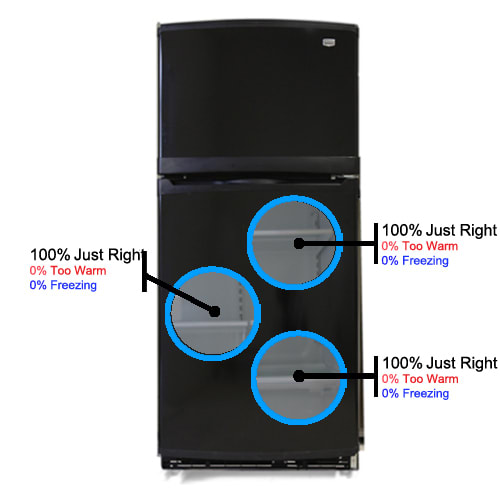
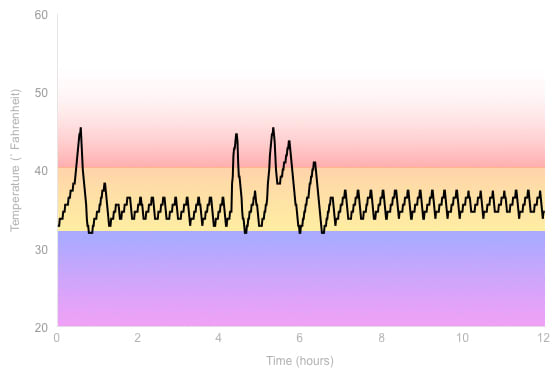
Freezer Temperature
{{section_header}}{{section.name}}{{/section_header}}
Over the three day testing period, the temperature in the {{product.name}}'s freezer fluctuated a very large amount. While food was always frozen, the temperature fluctuated noticeably, with the top of the freezer running warmer than is ideal. Freezer burn is much more likely to occur under such conditions, and you may find yourself throwing out a lot of food because of it.
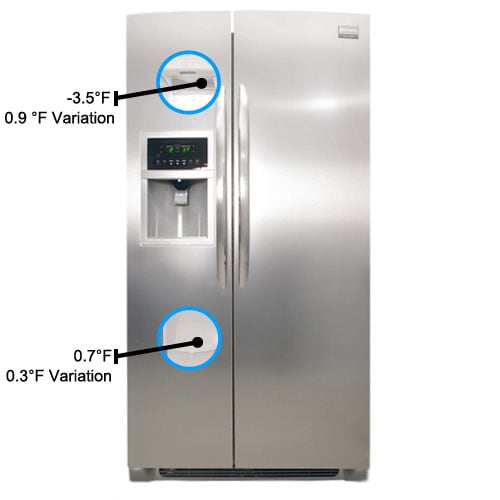
Vegetable Drawer
{{section_header}}{{section.name}}{{/section_header}}
The {{product.brand.name}}'s single vegetable drawer yielded consistently positive results for our humidity retention test. Setting the drawer to its highest setting in order to retain the most amount of moisture possible, we see just how quickly something placed here will dry out. Too much moisture lost means produce will wilt and spoil sooner than it should. Losing 0.16 grams per hour of water each day, produce placed in the {{product.brand.name}} will stay crisp for a longer amount of time than they would in many other fridges of this type.
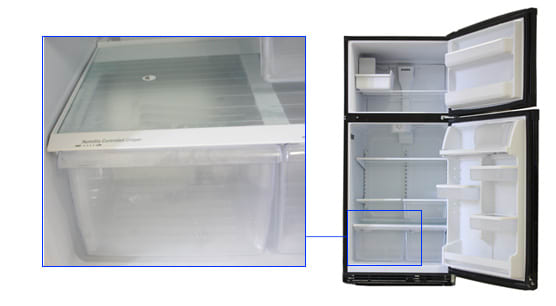
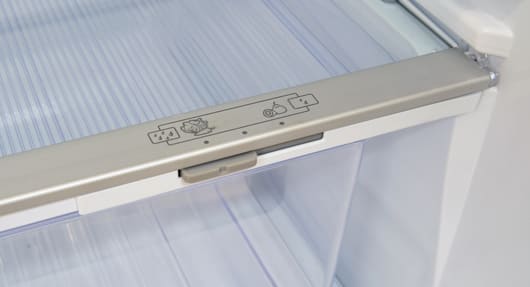
Power Loss
{{section_header}}{{section.name}}{{/section_header}}
The {{product.brand.name}} only managed to keep food frozen for up to 32 hours after we pulled the plug. This is poor, indeed - if the freezer door remains shut, the remaining cold air should keep temperatures low enough that nothing will defrost until after at least 36 hours. If you have this fridge and lose power, hope that your electric company gets things up and running, otherwise you'll be putting a lot of food out on garbage day.
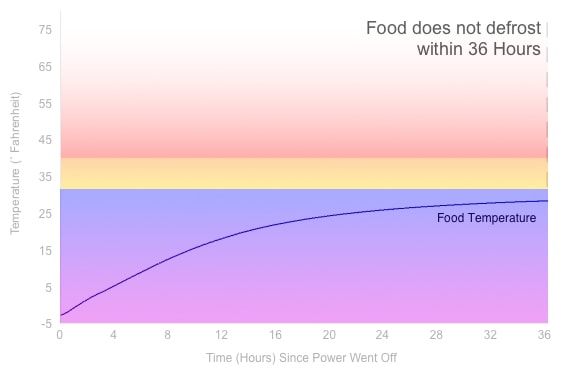
Freezing Performance
{{section_header}}{{section.name}}{{/section_header}}
In an ideal world, food would be flash frozen, preserving all of its freshness and nutritional value. Home freezers aren't exactly capable of this, but the closer we can get to instantaneous freezing, the better. The {{product.brand.name}} managed to bring our test material down to freezing from room temperature in 1 hour and 25 minutes. This is pretty good compared to similar fridges - it's not perfect, but it'll be good enough to keep your food well-preserved.

Usable Space
{{section_header}}{{section.name}}{{/section_header}}
The fridge portion of the {{product.name}} totaled 9.85 cubic feet of usable space. Our numbers are always lower than those produced by the manufacturer because we subtract space taken up by shelves and light fixtures from the overall capacity of the interior. As such, our total includes only the space that can be used for storing food spread out over the four shelves and three drawers.
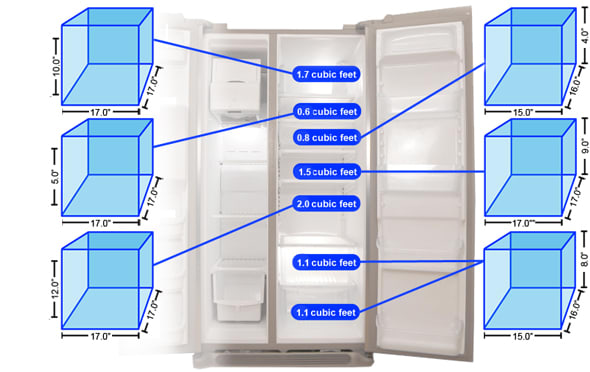
The storage space in the fridge also included what could be found throughout the four shelves on the door, in addition to the dairy tray.
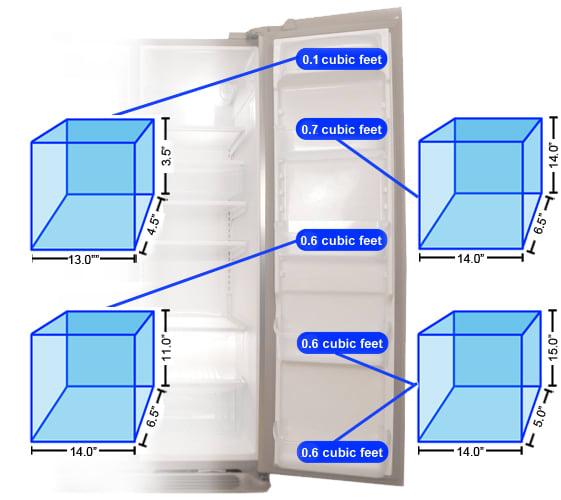
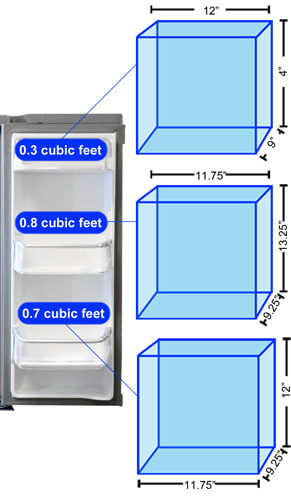
Usually, a side-by-side fridge offers extra storage space in either the fridge or the freezer, at the expense of the other compartment. The {{product.name}}, however, managed to find a solid balance between both sides, allowing for solid amounts of space without one side or the other becoming too cramped. The three shelves and the drawer in the freezer yielded 4.74 cubic feet of usable storage space.
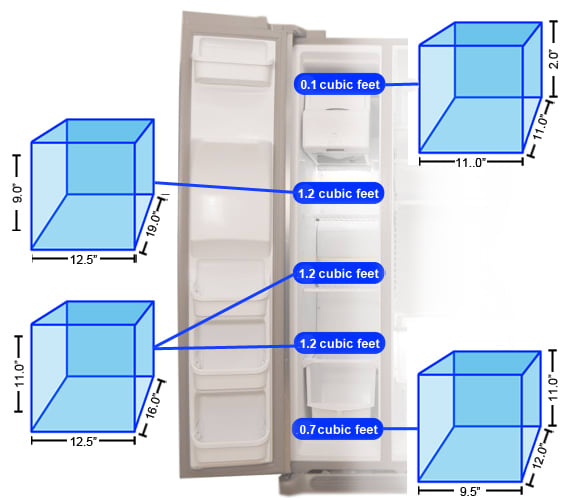
The shelves on the freezer door are very shallow, but did add a small portion to the overall storage capacity.
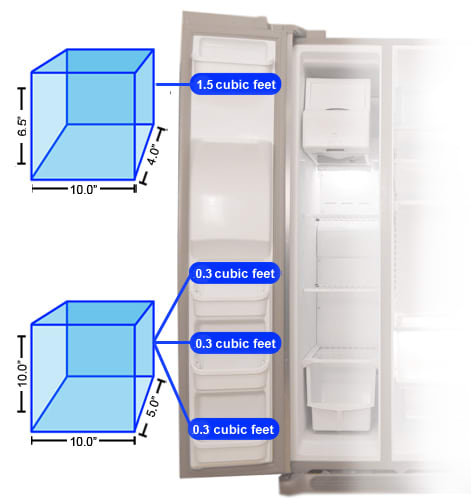
Below are the manufacturers own figures for capacity, and our own measurements for usable capacity. The manufacturers figures do not take account of the shelves, drawers and other removable features, but our measurements do account for the space these take up.
Ease of Access
{{section_header}}{{section.name}}{{/section_header}}
The shelves are wide and deep enough to offer easy access to nearly any location inside the {{product.name}}. With the exception of the "Fruits & Vegetables" tray, all the drawers, including the freezer basket, can stick going in and out. Also, the shelves are held in place using little plastic snags. These keep the shelves from being yanked out of the fridge, but are difficult to depress, meaning shelf adjustment becomes a pain. Also, the hooks for the door shelves are very unusual and difficult to manage, and they lock the shelves into place in such a way that they don't feel all that secure.
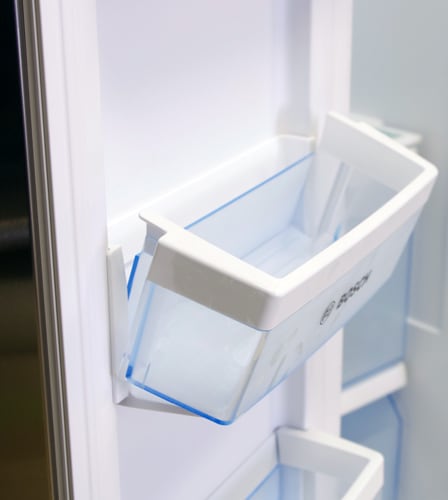
Controls
{{section_header}}{{section.name}}{{/section_header}}
The control panel is set above the water dispenser on the freezer door. Fridge and freezer temperatures can be adjusted separately, and are measured in degrees Fahrenheit. There are two warmer and colder buttons to raise and lower the temperatures, with the manufacturer's recommended setting just underneath that.
The controls are very easy to use, but could have been more streamlined. Separate buttons for different ice types make it seem just a tad cluttered. Temperature controls that are measured using an actual degree scale instead of an arbitrary "cold to colder" dial is refreshing, offering greater temperature accuracy for both sides.

Water Dispenser
{{section_header}}{{section.name}}{{/section_header}}
The water dispenser, like many through-the-door designs, is very straightforward. You push on a paddle, and water comes out. The {{product.name}}, however, has too small issues with its layout. The paddle's curved design is meant to fit the shape of an average water glass, but if you want to fill something that is larger than the curve, you may have some trouble. Also, the paddle doesn't even extend halfway into the cavity, meaning smaller glasses may also be slightly more difficult to fill.

Ice Maker
{{section_header}}{{section.name}}{{/section_header}}
The ice maker is located at the very top of the freezer, and its large size can make it a bit unwieldy to remove. GE took this into account, however, and has placed a doggie-door style flap to allow access to bulk ice without having to pull out the whole machine.

Cleaning
Noise
Other Features
{{section_header}}{{section.name}}{{/section_header}}
{{product.manufacturer_specs['Other Features Photo BROKEN?']}}
Conclusion
Energy Efficiency
The {{product.name}} isn't going to rob you blind in terms of electricity costs, but its not exactly winning points for thriftiness. An electric bill of $68.40 using our standard scale means this fridge isn't for those trying to stick to a tight budget, and you could do a lot better with respect to energy efficiency.
Performance
With somewhat questionable temperature consistency, you may find yourself throwing out more food than you should. With fluctuating temperatures that could result in spoiled goods in the fridge and frozen goods developing freezer burn, the {{product.name}} doesn't quite deliver as well as it should. Humidity retention was actually really solid, losing less than the average amount of moisture, so if nothing else, your produce will be well taken care of.
Storage Space
The {{product.name}} managed to strike a balance between its two sections, offering reasonable storage space in both its fridge and freezer. Neither side is particularly spacious, but then, neither side is particularly cramped, either. A good fit for households that shop for a balance of both fresh and frozen goods.
Usability
You shouldn't have any trouble accessing your good in this fridge, regardless of where you store it. Small complaints do crop up, though, such as sticky shelves on both sides. The shelves in both the fridge and on the doors are difficult to adjust, as well, so its best to find your ideal layout sooner rather than later.
Meet the tester
Matthew is a native of Brockton, MA and a graduate of Northeastern, where he earned a degree in English and Theatre. He has also studied at the Gaiety School of Acting in Dublin and spends most of his free time pursuing a performance career in the greater Boston area.
Checking our work.
Our team is here to help you buy the best stuff and love what you own. Our writers, editors, and experts obsess over the products we cover to make sure you're confident and satisfied. Have a different opinion about something we recommend? Email us and we'll compare notes.
Shoot us an email